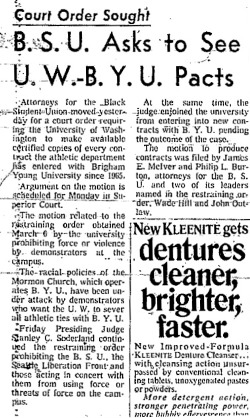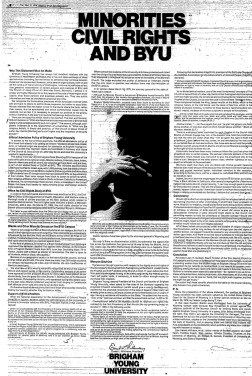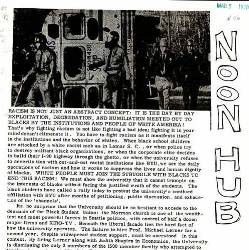In January of 1970 the Black Student Union (BSU) at the University of Washington launched a protest campaign demanding that the UW sever all athletic relations with Brigham Young University (BYU). Later, the BSU also demanded that the University make a statement condemning BYU as a racist institution. The protests were doomed to failure. The University believed that they could not legally sever relations with BYU on the grounds that doing so would infringe on the Mormon Church’s freedom of religion. For the BSU, the statement would have stood as a sign that the University was operating in good faith to end racism. But, the only compromise the administration could offer did not seem like such a gesture.
Inspired by successful protest campaigns at other universities, the UW’s BSU launched their own campaign against BYU in the first few weeks of the 1970 winter quarter. On a chilly Saturday afternoon in January, 20 blacks entered Hec Edmundson pavilion where the UW gymnastics team was finishing their final round of warm-ups before a scheduled meet against BYU. The protesters dumped garbage, threw eggs, poured catsup and oil on the gymnastics mats and knocked over chalk trays and tables.1 When the UW gymnastics coach yelled at the protestors to leave, they responded by throwing a pail of water in his face before departing. Meanwhile, Lynn Hall, a black gymnast, had begun circulating a petition requesting that the University cancel all future athletic competitions with BYU. The petition eventually gathered over 1,500 signatures .
BYU PROTESTS
Similar protests against BYU had been occurring for more than two years at numerous universities in the Western United States. The first protest occurred in 1968 at the University of Texas El-Paso. On Easter weekend in 1968, UTEP had a scheduled track meet against BYU. The week before the track meet several athletes informed their coach they were going to boycott the meet. The coach was unsympathetic and told the black team members that if they refused to compete they would be off the team and lose their scholarships. The black students refused to yield, did not go to Provo to participate in the meet, and were kicked off the team. When asked why he decided to protest, Dave Morgan, a UTEP runner, responded, “There were about a dozen reasons. The Mormons teach that Negroes are descended from the devil. As a reason for the track team’s boycott it may sound like a small thing to a white person, but who the hell wants to go up there and run your tail off in front of a bunch of spectators who think you’ve got horns.”2
The way blacks were treated at UTEP was a second reason for the protest. Black athletes were not allowed to date whites, were given little financial assistance beyond their scholarship and were often called “niggers” by their coaches. In the eyes of many administrators, coaches, and white students, black athletes came to college to compete, not get a degree. Once a black’s athletic eligibility was used up, he was often given little other financial assistance and forced to leave UTEP without a degree. Morgan, then, recalled that he also took part in the protest because “the Negro is treated like something out of the jungle here, and we wanted to express ourselves about that.”3
While the black athletes’ protest was big news on the UTEP campus, BYU’s record of racism and discrimination did not become national news until the fall of 1969 when 14 black football players at Wyoming were suspended from the football team for planning to protest against BYU. The University of Wyoming’s successful football team had 14 black players recruited from around the nation. Their coach, Lloyd Eaton, was known as a disciplinarian and had a strict policy against his students protesting. On October 15, 1969, three days before a game with BYU, the Black Student Alliance at the University of Wyoming delivered a letter to the university’s administration. The letter discussed the racial policies of the LDS Church and BYU and suggested that students and players protest in the upcoming game. The 14 blacks on the team met and, while unsure of the tactics they would use, decided to protest the LDS Church’s doctrine.4 The specific issue that the athletes were protesting was a Mormon Church policy that prohibited blacks from joining the priesthood. In the Mormon Church the priesthood was not a professional order and all males entered the priesthood at age 12. Without being allowed into the priesthood blacks, could not marry in the temple, hold important leadership positions in the church, or enter the highest level of heaven. In short, the Mormon doctrine viewed blacks as spiritually inferior.5 After tentatively deciding to protest, the Wyoming football players broached the matter with their coach. Eaton immediately railed the blacks for even considering a protest, revoked their scholarships and dismissed them from the team. Since Wyoming was a nationally ranked team, film crews from the three networks descended upon Laramie to cover the administrative, faculty, and student meetings that followed the dismissals.6
The national exposure of the Wyoming protest kicked off a flurry of protests against BYU and Wyoming. Police were called to stop violence at a BYU-Arizona State basketball game. At the University of New Mexico the student senate demanded that the college end any relations with BYU.7 In early November Stanford announced that it would schedule no new athletic events or competitions of any nature with BYU. Kenneth Pitzer, Stanford’s president, defended the decision by stating, “It is a policy of Stanford University not to schedule events with institutions which practice discrimination on a basis of race or national origin, or which are affiliated with or sponsored by institutions which do so.”8 Outraged alumni and community members, as well as BYU, immediately criticized Stanford’s new policy by arguing that it violated the Mormon Church’s freedom of religion. Only if BYU itself discriminated should such a step be taken. Later, when the BSU at the University of Washington demanded a similar statement, administrators would remember the virulent attacks against Stanford’s policy.
The football season ended, but the protests against BYU continued into January, spreading to other campuses including the University of Washington. The week following the protest at the UW-BYU gymnastics meet, the BSU presented a letter to Joe Kearney explaining why the UW should end all athletic competitions with BYU. The letter argued that “the University of Washington, by allowing its athletes to participate in any events against a university (BYU) that openly professes white supremacy, is in fact, condoning racism.” Instead of arguing why the University should agree to halt further athletic contests against BYU, the BSU took a more militant stance. They vowed that if the University did not enforce a ban on any further contests, they would. “We have already decided that BYU will not participate in any athletic events against the University of Washington.” The letter continued by threatening the power structure of the Athletic Department. “If the Athletic Department doesn’t like it … RIGHT ON … she can shove it because her rule of conduct and behavior, her disciplinary courts, and her force and power will be dealt with accordingly, by the Black Student Union and the black community.”10
BSU ORIGINS
From the beginning, the protest at the UW was more militant than the protests at either UTEP or Wyoming. In order to understand the goals and the tactics of the BYU protest at the University of Washington, a brief examination of the Black Student Union’s history is needed. In The Forging of a Black Community, Quintard Taylor traces a split in the Seattle Civil Rights Movement. In the early 1960’s the Movement was able to overcome differences within the black community and develop a single leadership that supported one set of goals and tactics. But in the late 1960’s a younger, working-class group emerged that spoke out against integration in favor of black power. Black power advocates believed that white racism precluded the possibility of meaningful integration and that blacks needed to empower their own communities. Larry Gossett, one of the first leaders of the BSU at the University of Washington reasoned that, “the best choice I feel black people can make is to continue to build a strong, creative, and innovative black community.”11
In January 1968, out of this new atmosphere of black power and militancy, the Black Student Union formed when the UW Student Afro-American Society and the UW chapter of SNCC merged. Leaders of both groups decided to form the new group after attending a conference held in San Francisco sponsored by the Black Panthers.12 Along with these ties to the national Black Panther organization, ties to the Seattle Black Panther chapter were also strong, with many members of the Black Student Union also belonging to the Black Panthers. Shortly after forming, the BSU wrote a position paper that outlined “the philosophy and goals of the Black Student Union at the University of Washington.” The paper enumerated four basic beliefs: that black people are human beings; that white America is racist and looks upon black human beings as “niggers;” that some form of education is essential for black people; and that black students must do something for themselves and their people.13 The paper went on to emphasize that the BSU would not be passive. “A key assumption of our BSU” the paper stated, “is that we should take the initiative, not only react; that we should define, not be defined.”14
A few months later the BSU presented the initiative to the University Administration with a list of five demands. They demanded that the University develop a Black Studies Program, recruit more black teachers and administrators, and that the BSU should be given the necessary resources to recruit non-white students. After a series of negotiations with the administration the BSU turned to more militant tactics. On Monday, May 20, forty Black Student Union protestors entered the campus administration building where the Faculty Senate was meeting. After heated arguments between the protesters and administrators, UW President Charles Odegaard fled to an inner office where he was barricaded in by the protestors. Odegaard and the protesters were eventually able to negotiate over the phone and reached an agreement. The agreement met most of the BSU’s demands.15 Following the sit-in, the BSU continued to remain active, although they did not launch another major protest campaign until the BYU protests of 1970.
KEARNEY INVESTIGATION
The week following the gymnastics demonstration at Hec Edmundson, Joe Kearney, Director of Sports, began to investigate the possibility of the UW not scheduling further athletic contests with BYU. Kearney would later claim that he was not pressured by the disruptive tactics of the BSU and that the real catalyst for his investigation was the petition submitted by Lynn Hall. This seems not to be the case for his investigation started on February 3, six days before Hall submitted his petition.16 Kearney meticulously conducted his investigation by meeting with numerous groups that had a stake in his decision. The groups included black athletes, Mormon leaders, student-athletes of the Mormon faith and the Alumni Board of Directors. He even met with a Catholic priest, a Jewish Rabbi and a Protestant minister, all of whom were active in the black community. Kearney asked each group if they felt the Mormon religious tenet was objectionable, and what steps, if any, the University should take against BYU. All of the non-Mormon groups he initially interviewed “felt the religious tenet to be repugnant” but disagreed on what shape the University’s policy should take.17 Kearney conducted the investigation without a sense of urgency—the next meet with BYU was not scheduled until January of the following year.
What Kearney believed to be a reasonable pace for the investigation was viewed as stalling tactics by the BSU. On February 19, the BSU demanded that the administration make a definite decision on the future scheduling of athletic contests with BYU within ten days. The BSU set February 24th as the date when the countdown would begin. If the administration failed to act, the BSU promised it “will then act accordingly.”18 The BSU had a profound distrust of American institutions and the mechanisms of those institutions. Too often white-America hid behind bureaucratic structures to prevent blacks from exercising their constitutional rights. BSU activists believed that institutions like the University of Washington were inherently racist and that real racial progress could only occur outside of the bounds of those institutions. The BSU’s original statement to Kearney demonstrated that they believed they did not need the University’s traditional channels of power to end the UW’s relationship with BYU, they would use a different kind of power—disruptive protest tactics. Yet, at the same time, the BSU could not escape operating through traditional channels of institutional power. The BYU protests were almost entirely aimed at trying to get the administration to officially sever relations with BYU. Later on, the BSU would raise the stakes, demanding that the administration not only sever all relationships with BYU, but also make a statement denouncing BYU as a racist institution.
March came and Kearney had yet to make a decision. In a letter dated February 27, he informed the BSU that, “In view of the many meetings yet to be held, and other factors, it is not conceivable that a decision and/or announcement will be made within the 10-day span in your letter of Feb 19.”19 One day before their March 5 deadline the BSU announced that it would “act accordingly” against the University’s silence. In a letter sent to Kearney and released to the Daily, the BSU claimed Kearney was “allotted adequate time for a decision on BYU.” A BSU flyer complained that Kearney would only promise “more bullshit committee meetings.”20 The BSU flyer argued that the University needed to continue to take adequate steps toward ending racism. Supporting a racist institution made the University a complicit supporter of racism as well. “Blatantly condoning a racist institution which is our enemy makes you our enemy too.”21 The BSU announced plans to hold a rally the next day at noon, protesting the administrations’ failure to act. Kearny responded to this announcement by stating he had managed to finish his report and that he had submitted it to the administration. The power to sever relations with BYU now fell to Executive Vice-President Dr. John Hogness, who was Acting President while President Odegaard traveled in Europe. Hogness released a statement that the administration would make a decision no later than April first. He argued that the administration still needed to consult with additional faculty, student groups and the Board of Regents.
The BSU rejected the administration’s plea for more time. They, along with other New Left and minority organizations, released another statement that asked, “what’s behind the perpetual motion machine of ‘fact-finding’?” The statement also accused the “inordinate economic and political influence in the Northwest of the Mormon Church” as perhaps the real reason the University refused to concede to the BSU’s demands. In 1970 the Mormon Church owned a number of retail stores along with a radio and TV-station in Seattle. This fear that Mormon economic and political power could force the UW into taking a racist stance naturally followed from the BSU’s belief that all white institutions contributed to racism in America.
In that same statement the BSU addressed another major issue that surrounded the BYU protests. Did the University have the right to condemn the Mormon Church as racist when their anti-black doctrine was protected by the first amendment clause guaranteeing freedom of religion? The BSU argued that they were not disputing the right of any individual Mormon to believe anything he/she wishes. They were protesting because “when such an idea becomes institutionalized and seeks respectability by aligning with institutions like the UW … then the question is no longer that of religious freedom.”22
The administration also realized the legal implications of severing relations with BYU and consulted with the Assistant Attorney General, James B Wilson. Wilson, in an internal memo to Hogness, concluded that, on one hand, the University could not determine its relationships on the basis of creed, but, at the same time, could not knowingly participate in events with an institution which had a policy of racial discrimination. The BYU protests placed two fundamental rights in competition: the right to freedom of religion and the right not to face discrimination based on race. Fortunately, Wilson found a way to escape this dilemma. He argued that “since the only evidence the University has concerning Brigham Young University’s racial practices is that it does not discriminate on the basis of race, the University cannot declare a policy of refusal to engage in activities with BYU solely because of a creed of its religious sponsor, regardless of how strongly we may disagree with that religious creed.”23 BYU had, in fact, been inspected by the Office for Civil Rights in 1968. The conclusion reached was that BYU was in complete compliance with Title VI of the Civil Rights Act of 1964. The finding that BYU itself did not practice discrimination led the Assistant Attorney General to conclude that the UW could not legally declare a policy of refusal to participate with BYU because of the creed of its religious sponsor. The UW took the conclusions of this report very seriously and during the eight days of protest in March the administration believed that they could not legally make a statement condemning the Mormon Church for its racist doctrine as the BSU was demanding.
MARCH DEMONSTRATIONS
The first large-scale protest occurred as promised at noon on Thursday, March 5. Almost 1,000 students met at the Husky Union Building (HUB) to hear speakers from the black community along with speakers from New Left organizations on campus. The Seattle Liberation Front, a radical New Left protest group, helped organize the rally and provided one of the speakers. After the speakers finished, the crowd marched across campus to the administration building where ten BSU representatives met with Hogness. Hogness reiterated that the University did not support racism in any form, but that he could not move up the decision date. The crowd then moved across campus and entered and occupied Thompson Hall, an academic building near the HUB. The tactic of occupying buildings was not new to student protests, and the BSU chose not to occupy the administration building because they believed the building to be protected by policemen in riot gear. The demonstrators quickly hung two banners from Thompson Hall—one read “Occupied,” the other “Marx Hall.” The demonstrators were planning on staying in the building until, according to Larry Gossett, “the University reevaluates its position on the BYU issue.”24 The prolonged occupation only lasted until 3:30 when the BSU decided to give the University one more day to make a decision.
The next day, again at noon, an even larger group of protesters met at the HUB. A heavy rain drove the protest indoors where more speeches were made. After the rally the BSU led students on a march around campus. This time the protesters used what the administration would later characterize as “hit and run” tactics. Protesters ran into buildings, entered classrooms and ordered the students there to leave. After occupying the building for ten minutes, the protesters would move on to another building. The administration called on the Seattle Police Department to end the demonstration, but BSU leaders, suspecting that the police had been called, decided to end the protest before the police could arrive. The Friday protest ended at the administration building where a BSU leader told the crowd, “We’re going to lay dead until noon Monday and then the shit is going to fly again.”25
Swiftly reacting to a second day of protests, Hogness obtained a temporary restraining order from the Superior Court of King County. The restraining order enjoined the Seattle Liberation Front, the BSU and “all others acting in concert” from “employing force or violence, or the threat of force or violence, against persons or property on plaintiff’s premises” along with four other edicts.26 In Monday’s _Daily,_ Hogness had the restraining order published as a letter to the University community and added that he “deeply regrets the necessity of this type of action. Thank you all for your cooperation.”27
Reacting to the demonstrations, Seattle’s two major newspapers, the _Seattle Times_ and the _Seattle Post-Intelligencer,_ published editorials. Both papers, surprisingly, defended the BSU and instead blamed the disruptions on the Seattle Liberation Front. The _P-I_’s editorial, which appeared on the front page of its Friday edition, argued that “Last week the Black Student Union, which previously had provided some responsible leadership at the University of Washington, demonstrated that it had become the dupe of the revolutionary Seattle Liberation Front. On two successive days the BSU, with the prodding of the Seattle Liberation Front very much in evidence, lost its reason and took over buildings on campus.”28 In a similar editorial the _Seattle Times_ wrote that “The intrusion of the Seattle Liberation Front onto the scene of trouble is an affront to the blacks as well as to the university community. This revolutionary group has seized upon the blacks grievance only as a means to its completely destructive objective of ‘destroying the system.’”29
The historical evidence does not support the editorials’ interpretation of events. The first demonstration against BYU did not involve the SLF. When the _P-I_ wrote that, in the past, the BSU had provided reasonable leadership, perhaps they were thinking of the 1968 sit-in. The statement delivered to Kearney in early February, where the BSU threatened even more effective protests against future competitions with BYU, clearly showed the willingness of the BSU to use disruptive tactics in order to achieve their goals. The SLF itself mocked the _PI_ editorial and noted that if you believed what was written, “the fact that the leadership of the battles Thursday and Friday last week was black is irrelevant.”30
If the newspapers’ view was not very accurate, why were they so willing to apologize for the BSU? The newspapers’ interpretation was influenced by the legitimacy the civil rights movement had achieved by 1970. The papers conceded that racism did exist and that blacks had a right to work to alleviate that racism. _The Seattle Times_ wrote that “the grievance being pursued by the Black Student Union is understandable.” The papers did not protest the goals of the BSU only the tactics they used. It also seems the newspapers were afraid to attack the BSU at the risk of being labeled racist themselves. The papers claimed that the BSU itself was not to blame for the vandalism and violence of the protests, they were simply dupes of the SLF.31 By making the BSU dupes the papers could attack the actions of the BSU, without attacking the BSU itself. White guilt and the fear of being labeled racist seems to have played a role in how the newspapers chose to interpret the BYU protests.
The weekend brought a flurry of meetings and negotiations for Hogness. He met with representatives from the Faculty Senate, administration, and student body, where they discussed what stance the University should take on BYU and how to prepare for the possibility of more demonstrations the following week. He also consulted with officials from the Seattle Police Department, the Governor’s office, the National Guard and other state officials. Hogness was under pressure from many members of the state legislature to take a tougher stance against the protesters. He decided that if any further demonstrations were to occur, the Seattle Police would immediately be called in, and if they couldn’t deal with the situation, the National Guard would be used. Unlike U.C. Berkeley, the UW was located in a city with a substantial police force and Hogness did not have to immediately resort to calling in the National Guard, a move that sometimes proved fatal in other campus protests around the nation. After consulting with the Board of Regents, Hogness developed an official University position on BYU. The University would honor all current contracts with BYU, but make no plans to enter into any further contracts. Hogness also emphasized that “no student is required to participate in any event with any institution if he objects to participation as a matter of conscience.”32
STALEMATE
This statement did not satisfy the BSU. They argued that what Hogness’ compromise really meant was that the University’s complicity with the racism of BYU will continue through 1972. “The BSU will not accept a ‘pat on the head’ and the advice to ‘run along and be good boys and girls.’”33Instead of running along, on Monday the BSU held another massive protest. The protest attracted an estimated 3,500 students who marched from the HUB to the administration building where BSU leaders again met with Hogness. The BSU had originally “planned to go to the library and do a little research on racism, but it’s been closed down. Now we’re going to the Ad building to ask Hogness why it’s closed …”34 The administration building was also locked, and had its doors protected by policemen in riot gear. After twenty minutes Hogness addressed the crowd and repeated the administration’s Sunday statement. He also reiterated his pledge to work to eradicate racism from campus.35
Documents show that at that juncture there was no chance for the BSU and the administration to come to terms over BYU. The administration believed that they could not legally make a statement condemning the Mormon Church for a religious doctrine. Nor did they believe they could legally break contracts with BYU. The only step the administration could take was to promise that no future contracts with BYU would be made. While different members of the BSU were protesting for slightly different reasons, in general their demands were largely symbolic in nature. The Mormon Church’s anti-black doctrine symbolized institutional racism in America, and a statement against the doctrine meant the University was acting in good faith to eliminate racism. Rarely did BSU members ever express the belief that their protests might force the Mormon Church to change its doctrine. The BSU wanted the University to take a stance against racism; a stance that they understood would be largely symbolic in nature. To the BSU, Hogness’ compromise, in meeting only one of the group’s three demands was an empty shell of one-third of a symbol.
Tuesday, March 10, brought a day of quiet to the UW campus. The BSU announced that it had no plans to rally that day before the crowd of students who had gathered at the HUB to participate in or watch the rally. The administration, working to appease the demonstrators, made a second concession, and announced the formation of a Human Rights Commission that would act with broad powers to “root out racism wherever it is found on campus.”36 The membership for the commission would be “drawn from concerned student groups including the BSU, faculty, staff and administration.”37 In a speech given at the rally on Thursday, a BSU leader attacked the University’s formation of a Human Rights Commission. He called it “a bullshit trick. Black students sit on more committees than anybody else, yet racism still exists on this campus.” The BSU was tired of operating through traditional bureaucratic channels of power. They had tried to change the system by using the system and had failed.
VIOLENT ESCALATION
The BYU protests reached a climax on Wednesday when sporadic violence erupted, leaving 12 students injured. The rally again began at the HUB with the usual speeches berating the administration “for turning its face on racism while promising to end it.” About 700 demonstrators then briefly occupied over eight buildings on campus. Inside the buildings, they entered classrooms and demand that everyone leave. In a few classrooms, students refused to leave and angrily confronted the protesters. At least two such confrontations erupted into violence. In Smith Hall, Professor Carol Thomas was in the middle of her class on Ancient Greek History when several protesters entered the room and demanded everyone leave. Immediately, two students ran forward to confront the protesters. The confrontation between protesters and students turned violent. Wielding small wooden clubs, several protesters beat one student.38 A similar confrontation occurred in another history class. One protester who entered the room began to yell racial epithets and obscenities at the class. A female student yelled at him to stop. He responded by hitting the woman on the head with a stick yelling, “I told you to get out of here bitch.”39 Some 14 students were injured in similar incidents. The protesters eventually marched to the administration building where Hogness ordered them to cease their demonstration under threat of arrest and citation for contempt of court. The demonstrators did disperse and the police arrived too late to make any arrests.
The administration took this third protest very seriously and launched detailed investigations to determine which classes were disrupted by the protestors, what damage they caused, and to identify the protesters who committed assault. The administration contacted every professor whose class might have been disrupted and discovered that 14 classes were disrupted and dismissed, 15 classes were disrupted and continued and that 9 were not disrupted but dismissed.40 The physical plant submitted a detailed report that estimated the damage totaled $1,500. The political science library also submitted a meticulous report that listed the exact damage rout by the protesters. Included on the list was the disruption of the contents of the coffee room with the noted loss of “coffee, sugar and one cup at a total estimate of $6.50.”41
The administration also resolved to identify and arrest the demonstrators who had assaulted the students in the two history classes. Depositions of all witnesses were taken, but the University had a hard time identifying the protesters, many of whom did not attend the UW. While it is not clear how they obtained them, the files on the investigations that followed the assault are filled with large glossy black and white photographs of students walking on campus. The heads of some of these students are circled and numbered and these photos were used during the sworn depositions to confirm the identity of the assailants. These photos are one example of how the tactics of the administration in dealing with the protestors confirmed the ideology of the protesters. The SLF believed that the military, governmental, industrial and university complex supported a racist society that was fighting an unjust war in Vietnam. These institutions would go to any length to protect their power, including resorting to secret undercover operations. That the University was unknowingly photographing students would only serve to confirm how far the establishment would go in trying to prevent the revolution of the New Left.
The University’s use of police also served to confirm the BSU’s claims about the willingness of the University to support racist institutions. In the South during the Civil Rights Movement the police were often used to prevent blacks from registering to vote or exercising their right to peaceful protest. The Black Panthers were founded in opposition to police activity in Oakland, and would follow police officers to prevent the police from committing racist crimes against blacks. As noted above, the Seattle Panthers also held neighborhood patrols, and some of the men who went on these patrols also were members of the BSU. Hogness understood the effect that police had on other college campuses, where they often turned a peaceful protest violent, and he initially hesitated to use the Seattle Police Department. Only after the second day of protests did Hogness call upon the police. The BSU noted his willingness to call on the police and argued that it proved how far the administration would go in its support of racism. One BSU statement noted that “Seattle Riot Police have already been on campus and the University had announced its willingness to call for the National Guard to enforce its racist decision.”42 The SLF went even further and saw Hogness’ use of police as “a declaration of war against all oppressed peoples in revolution.”43
On Thursday, Hogness did not wait for violence before calling on the police. King County Sheriff’s officers along with Seattle Police arrived on campus early that morning and patrolled campus all day long. The BSU held a noon rally at the HUB, but noting the police presence, chose not to demonstrate. In a speech at the rally Carl Miller, a BSU leader, explained why. “University has shown us its true nature. They are morally bankrupt, politically inept and ‘Pigs.’” By bringing police on campus the University itself became no better than a southern born, black-hating policemen. He continued with a subtle attack on the non-violent tactics of the mainstream Civil Rights movement. “We don’t have to love our enemy, but we do have to respect him. Respect him for what he is—a viscous, murderous, lying, treacherous pig dog. And anybody here, who believes that those policemen that they got out there will not kill you, is in for a rude awakening. We do not intend to commit suicide. We do not intend to place our bodies in front of his guns and billy-clubs. The effect of that we’ve seen over and over again; people get hurt, and nothing changes.”44 The black students had grown up seeing blacks beaten by police, but to those students it didn’t seem to improve their lives. Miller’s speech demonstrates the wide gap between the ideology of the BSU and the ideology of the mainstream Civil Rights Movement.
Friday, March 15, was the last day of finals for winter quarter, and the BSU did not hold a rally. Miller’s announcement the day before that there would not be a demonstration ended two weeks of perhaps the largest and most disruptive demonstrations the University ever experienced. The official estimate listed over $11,000 in property damage and 15 students suffering injuries. During the last week of demonstrations dozens of letters criticizing Hogness for not taking a stronger stand against the protesters poured into the University. The letters came from primarily four sources: faculty and staff, alumni, and taxpayers.
FACULTY REACT
After the Wednesday disruptions, twenty-three members of the history department approved and sent a statement to Hogness that insisted that “prompt and effective protection of Smith and Thompson Halls be immediately provided around the clock…” They lambasted the administration for failing to take any countermeasures against demonstrations that exposed “our students, the staff, ourselves, our books, manuscripts, and papers to serious jeopardy.”45 In this sense the BSU’s tactics had their desired effect; the history department was genuinely frightened for their personal safety and the safety of their manuscripts. A letter written by Edward Alexander, an English professor, is particularly enlightening in demonstrating how the actions of the BSU reinforced the world-view of these conservative critics. Alexander believed the protests symbolized a reign of terror where “a mob has been allowed, during a period of several days, to roam unhindered from building to building, disrupting classes, destroying books and manuscripts in offices and libraries, and brutally beating students who attempted to resist.”46 The University, by taking no action against the protesters, opened “the floodgates to anarchy and to its natural sequel, tyranny.”47 In short, the protests were the unlawful actions of a minority trying to impose its tyrannical will on society.
The violence of Wednesday’s demonstrations only served to strengthen Alexander’s view of the BSU. In turning to violence, the BSU fell into a trap that the non-violent tactics of Civil Rights Movement was able to escape. During the Montgomery Bus Boycott, for instance, the Klan marched through the black neighborhoods of Montgomery. Instead of reacting with violence or fear, blacks stood on their porches in their Sunday best and applauded the Klan. The Klan only marched a few blocks before leaving, for they could not comprehend why their march was met without resistance.48 In the South, black violence against whites only served to confirm the belief that blacks needed to be kept in their place. Black violence served to justify the system of white supremacy. When blacks ceased to react with violence, whites were unsure how to react. For Alexander, the tactics used by the BSU revealed their true tyrannical nature and the need for local police action. For the BSU, the use of police action only served to demonstrate the tyrannical nature of racist institutions and the need for more radical tactics to break the power of those institutions. The BYU protests only served to reinforce the world-views of these groups and further polarize them.
Fortunately, not everyone involved in the BYU protests subscribed to these extremes. Hogness showed great caution in the use of police action on campus and was willing to compromise with the demands of the BSU. The BSU itself, ignoring its own revolutionary rhetoric, hesitated to endorse violence. While speaking against the system, they often seemed more than willing to work within the system to affect change. The reason the BYU protests did not come to a successful resolution was due to the nature of the issue. The University believed they could not legally make a statement condemning BYU. And compromise was not possible for the BSU; by refusing to immediately sever relations with BYU the administration was not taking the symbolic stand against racism wanted by the BSU.
Perhaps realizing they had nothing to gain with further protests, when students returned to campus for spring quarter the BSU held no new demonstrations. This lull of protests did not last long because the Kent State killings spurred another round of massive campus disruptions. On April 10, the Faculty Senate tabled a motion that would have severed relations with BYU and the motion died. A year later, the University renewed its contracts with BYU. In 1978, Mormon Church changed their anti-black doctrine when Spencer Kimball revealed that “all worthy male members of the church may be ordained to the priesthood without regard for race or color.” Upon hearing the announcement, a black professor commented that “the last major organized public racism in this country dropped on Friday.”49 The members of the BSU who participated in the BYU protests of 1970 certainly would have wholeheartedly agreed with that statement.
Copyright © 2007 Craig Collisson
This essay is derived from Craig Collisson’s PhD dissertation:
“Manifestos, Bureaucracies, Race, and Identity: Black Student Protest at White Universities, 1967-1973”
(Ph.D dissertation, University of Washington, 2008)
1 Salt Lake Tribune. Sunday, February 1, 1970.
2 Jack Olsen. _The Black Athlete, A Shameful Story_ (New York: Time-Life Books, 1968) 70.
3 Ibid, 72.
4 The Mormon Church’s official name is the Church of Jesus Christ of Latter-Day Saints
5 There were two stories that explained why blacks were not allowed the priesthood. They were not official doctrine of the Church, but believed by a number of church members. Mormons believe that before being born on the earth, all humans are already born as spirits in heaven. One story claimed that in a battle between God and Lucifer some spirits remained neutral. God then cursed these spirits, and when these spirits are born on earth, they are given black skin as a sign of their curse. The second story claimed blacks were cursed on account of their lineage from Cain and Ham. Both these stories hold that blacks are inferior and cannot reach full salvation regardless of their actions on earth. As late as 1958 these stories were still perpetuated by Mormon leaders. Bruce McConkie, a high ranking Mormon leader, wrote then that “Cain, Ham and the whole Negro race have been cursed with black skin, the mark of Cain, so they can be identified as a caste apart.”
6 Clifford Bullock, “Fired by Conscience: The ‘Black 14’ Incident at the University of Wyoming and Black Protest in the Western Athletic Conference, 1968-1970,” _Wyoming History Journal_ 68 no. 1 (1996): 9-10.
7 Ibid, 9.
8 Salt Lake Tribune. November 13, 1969.
9 Salt Lake Tribune. January 9, 1970.
10 Daily. February 6, 1970, 1.
11 Quintard Taylor _The Forging of a Black Community: Seattle’s Central District from 1870 through the Civil Rights Era_ (Seattle: University of Washington Press, 1994) 218.
12 Dianne Louise Walker. The University of Washington establishment and the Black Student Union sit-in of 1968. (Unpublished Thesis, 1980) 48.
13 A two page paper outlining the beliefs and goals of the BSU at UW. Black Student Union Papers.
14 Ibid.
15 Taylor, 222-223.
16 _Daily._ February 11, 1970, 1.
17 Two interdepartmental correspondence from Kearney to the Vice President for Student Affairs, Alvin Ulbrickson. WU Vice President of Student Affairs, 84-39 Box 1.
18 _Daily._ February 20, 1970, 1.
19 _Daily._ March 4, 1970, 1.
20 A flyer titled BYU, UW and You. Dated correctly? 3/4/70. Black Student Union Papers
21 _Daily._ March 4, 1970, 1.
22 BSU statement “To the faculty and students of UW.” WU President for Student Affairs 84-39 Box 1.
23 Memo from James B Wilson, Assistant Attorney General to Hogness dated March 10, 1970. Provost’s Office Records.
24 Daily. March 6, 1970, 1.
25 Seattle Times. Saturday, March 7, 1970.
26 Daily. Monday March 9, 1970, 6.
27 Ibid.
28 Seattle P-I. Friday, March 9, 1970, 1.
29 _Seattle Times._ Friday, March 9, 1970.
30 Seattle Liberation Front Flyer. WU Vice President of Student Affairs 84-89.
31 Of course, this can be interpreted the other way, that blacks had no agency and needed white leadership to engage in any action, and that the newspapers’ view was inspired by racism.
32 Hogness’ report to Alumni and others. WU Vice President of Student Affairs 84-39.
33 A flyer to a BSU at Cleveland High School. WU Vice President of Student Affairs 84-89.
34 _Daily._ Tuesday, March 10, 1970, 1
35 Ibid.
36 Seattle PI. Wednesday, March 11, 1970, 7.
37 Daily. Wednesday, March 11, 1970, 2.
38 Carol Thomas’s sworn deposition. Provost’s Office Records.
39 _Daily._ Thursday, March 12, 1970, 1.
40 Report addressed to Vice Provost Robert Ritchie. Solomon Katz Papers.
41 Report submitted by the political science library. Solomon Katz Papers.
42 A flyer to a BSU at Cleveland High School. WU Vice President of Student Affairs 84-89.
43 Ibid.
44 Transcript of Miller’s Speech. Black Student Union Papers.
45 Memo to the History Department explaining the action they had taken. Provost’s Office Records.
46 Letter addressed to Odegaard dated March 18, 1970. Provost’s Office Records.
47 Ibid.
48 Howell Raines. My Soul is Rested: Movement Days in the Deep South Remembered. (New York: G.P. Putnam’s Sons, 1977) 56.
49 Eric Lincoln, _Race, Religion, and the Continuing American Dilemma_ (New York: Hill and Wang, 1984.) 154.

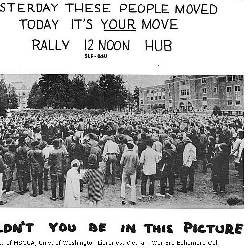
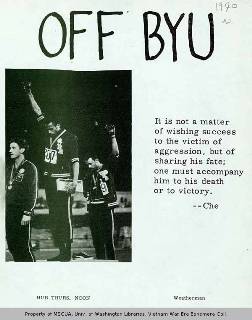
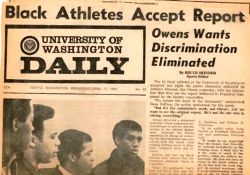
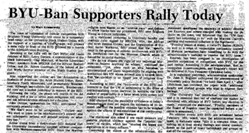

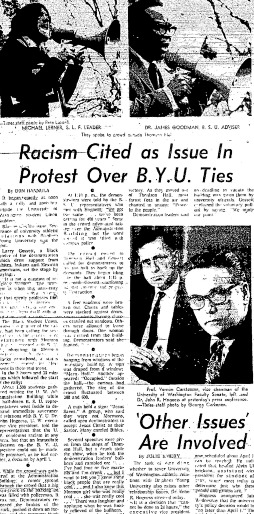
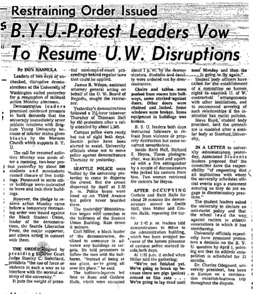

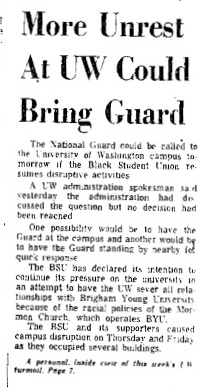
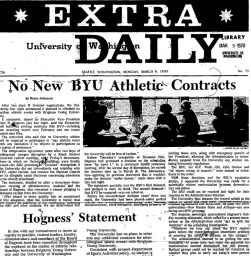
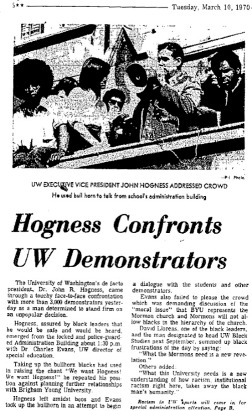
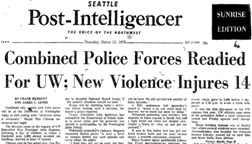
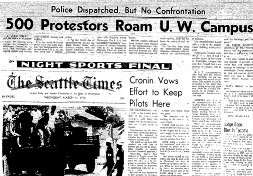

.jpg)
.jpg)
